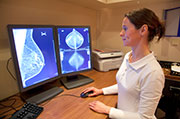- Skip Storing This Everyday Product in the Fridge Door
- Green Tea + B3 Pairing May Boost Brain Health
- Navigating Your Midlife Crisis: Embracing New Possibilities
- City Raccoons Showing Signs of Domestication
- Mapping the Exposome: Science Broadens Focus to Environmental Disease Triggers
- One Week Less on Social Media Linked to Better Mental Health
- Your Brain Changes in Stages as You Age, Study Finds
- Some Suicide Victims Show No Typical Warning Signs, Study Finds
- ByHeart Formula Faces Lawsuits After Babies Sickened With Botulism
- Switch to Vegan Diet Could Cut Your Greenhouse Gas Emissions in Half
Doctors May Need to Revise How They Evaluate Breast Biopsy Results


Two types of breast tissue abnormality may have the same potential of progressing to breast cancer, contrary to current belief, according to a new study.
One abnormal tissue finding is known as “atypical ductal hyperplasia” (ADH), an accumulation of abnormal cells in a breast duct. The other abnormal finding is “atypical lobular hyperplasia” (ALH), an accumulation of abnormal cells in a lobule, a small part of a breast lobe that makes milk.
Previously, many experts believed that ADH leads to low-grade ductal breast cancer in the same breast where the biopsy was done, and so it requires complete surgical excision. Meanwhile, many believed that ALH was simply an indicator of increased risk of breast cancer later in both breasts, so it did not require complete surgical removal but perhaps just closer monitoring.
The new research challenges that thinking, suggesting that the two types of abnormalities actually behave in similar ways.
“We were not so sure what to do with ALH before,” said study researcher Dr. Lynn Hartmann, a professor of oncology at the Mayo Clinic, in Rochester, Minn. “This is suggesting, treat it the same as ADH. What we are saying is, it doesn’t matter which kind [of abnormality].”
The study is published in the February issue of Cancer Prevention Research.
In the study, Hartmann’s team identified nearly 700 women (from a larger group of Mayo patients who’d undergone breast biopsies) who had confirmed abnormal cells but no cancer. While 330 of them had ADH, 327 women had ALH and 32 had both.
Hartmann followed the women for an average of 12.5 years. During that time, 143 developed breast cancer.
A similar number of women with either abnormality developed breast cancer in the same breast within five years, the study found. That suggests that ALH may be both a precursor to cancer and an indicator of increased risk, Hartmann said. While some experts believed ALH mostly would lead to lobular cancer, the study found it actually resulted in more ductal cancers, which is how ADH sometimes behaves.
The findings may apply to many women who have to undergo a biopsy, she said. “There are over a million biopsies a year with benign findings,” Hartmann said. “About 10 percent of those biopsies reveal atypical hyperplasia.” Those findings are classified as either ADH or ALH.
Atypical hyperplasia is different from usual hyperplasia, which is an overgrowth of cells, according to the American Cancer Society. In usual hyperplasia, the pattern of cells is very close to normal.
The new findings suggest that women with either kind of atypical cells — ductal or lobular — ask their doctor about closer surveillance and preventive treatment, or chemoprevention (taking anti-cancer drugs to lower the risk), Hartmann said.
Both types of abnormal cells found on a benign biopsy need attention, another expert agreed.
“This is a diagnosis you should pay attention to,” said Dr. Steven Chen, an associate professor of surgery at the City of Hope Comprehensive Cancer Center in Duarte, Calif. He reviewed the new study.
When he finds either of these abnormalities on a benign breast biopsy, he tells women: “You do not have cancer, but you have these atypical cells.”
If a woman has a needle biopsy and finds out she has atypical cells — either kind — she should see a surgeon, Chen said. “The typical response will be, ‘You need a surgical biopsy, in which a larger sample is taken.’ “
In most cases, a woman will also be followed more closely, usually with instructions to return to the doctor’s office every six months, Chen said. The doctor will usually perform a breast exam or also repeat a mammogram or other type of imaging more frequently than for a lower-risk women, he said.
“This [diagnosis] makes you high risk,” he said. “Find a doctor who knows about high-risk management.”
The study was funded by the Mayo Clinic Breast Cancer Specialized Program of Research Excellence, the U.S. National Institutes of Health and the Komen Foundation. One co-author reported a research grant from the drug company Pfizer, and another is a Pfizer consultant.
More information
To learn more about abnormal breast exam findings, visit the American Cancer Society.
Source: HealthDay
Copyright © 2025 HealthDay. All rights reserved.










